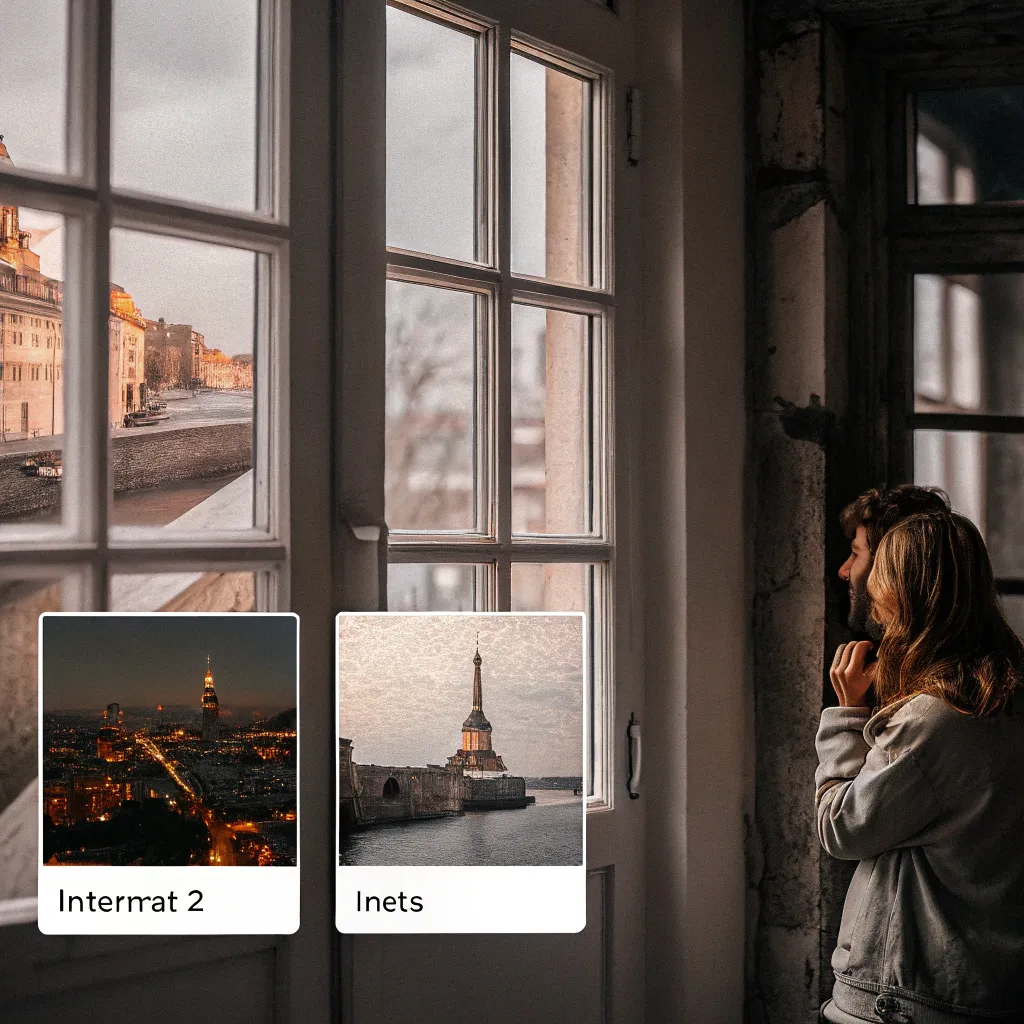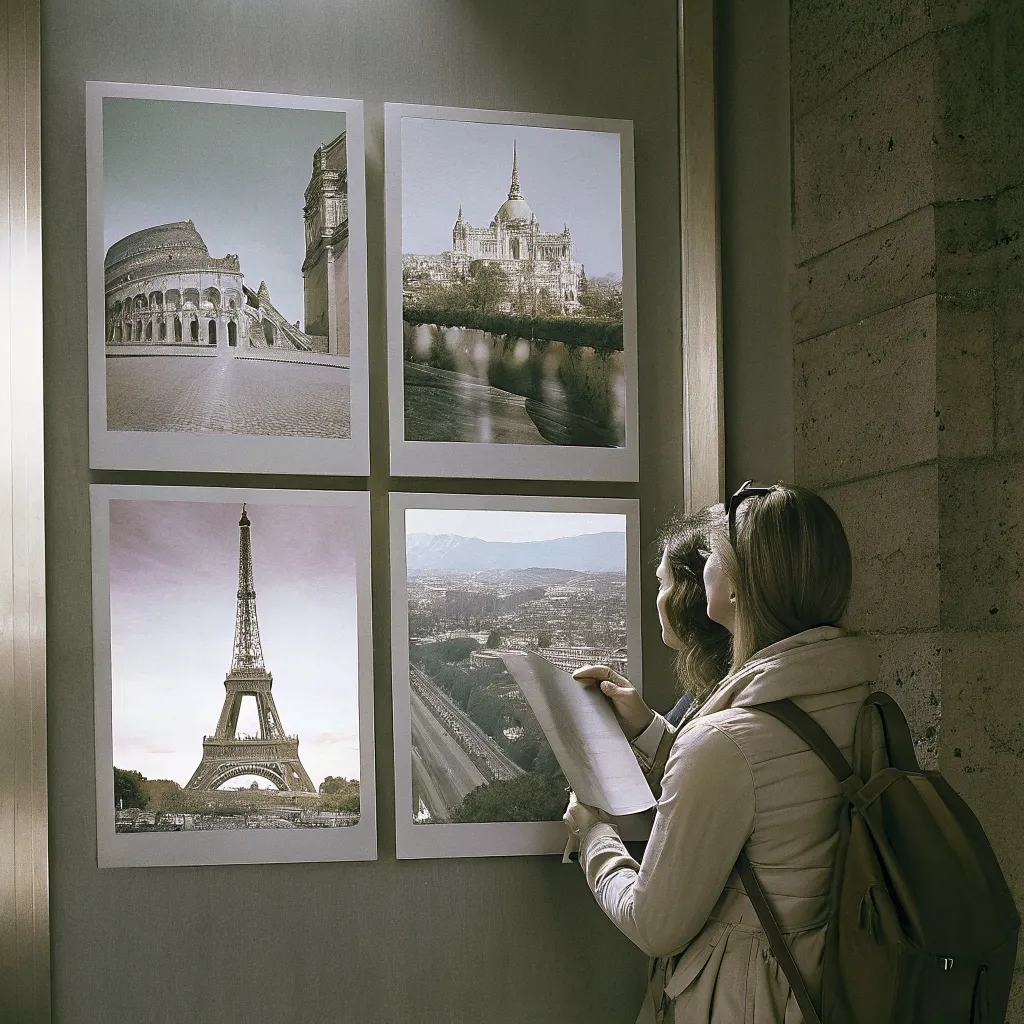Planning a week in Europe can feel overwhelming with so many incredible destinations to choose from. Whether you're drawn to historic landmarks, culinary adventures, stunning landscapes, or vibrant nightlife, the perfect European itinerary depends entirely on your personal interests. I've crafted several 7-day itineraries tailored to different travel styles to help you make the most of your limited time on the continent.
For History Buffs: Rome to Florence
If ancient ruins and Renaissance masterpieces make your heart race, this Italian itinerary delivers centuries of history in just one week.
Days 1-3: Rome
Begin your historical journey in the Eternal City, where ancient civilization meets Renaissance splendor. On day one, visit the Colosseum and Roman Forum in the morning. The scale of these ancient structures is impossible to appreciate from photos alone – standing inside the Colosseum, imagining the roar of 50,000 spectators, creates a connection to history that's genuinely moving.

Spend your afternoon exploring the charming streets of Trastevere, where you can enjoy authentic Roman cuisine at local trattorias. I stumbled upon a tiny family-run place called Da Enzo that served the best cacio e pepe I've ever tasted.
Dedicate your second day to Vatican City. The Vatican Museums, Sistine Chapel, and St. Peter's Basilica require at least half a day. Pro tip: book your tickets online in advance to skip the notoriously long lines. The Sistine Chapel ceiling will leave you with a sore neck but an impressed soul.
On day three, explore the Spanish Steps, Trevi Fountain, and Pantheon – all within walking distance of each other. End your Rome stay with a sunset view from Palatine Hill, overlooking the Forum.
Days 4-5: Florence
Take an early train to Florence (about 1.5 hours on the high-speed line) and head straight to the Uffizi Gallery to marvel at works by Botticelli, Michelangelo, and Leonardo da Vinci. The Birth of Venus is even more captivating in person.
Reserve your second day in Florence for the Accademia Gallery (home to Michelangelo's David) and the magnificent Duomo. Climbing to the top of Brunelleschi's dome offers stunning views of the terracotta rooftops below. Finish your evening with a stroll across the Ponte Vecchio at sunset.

Days 6-7: Tuscan Countryside
Rent a car or join a tour to explore the medieval towns of Tuscany. San Gimignano, with its distinctive towers, and Siena, home to the famous Palio horse race, are both worthy destinations. The rolling hills dotted with cypress trees and vineyards provide the perfect backdrop for your final days in Italy.
End your trip with a wine tasting tour in Chianti before returning to Florence for your departure. The small family wineries often provide the most authentic experiences – I still remember Fattoria Poggio Alloro, where the owners treated us like family and explained their sustainable farming practices over a long lunch.
For Foodies: Spain's Culinary Capitals
Spain offers some of Europe's most exciting culinary experiences, from pintxos bars to Michelin-starred restaurants.
Days 1-2: Barcelona

Begin your gastronomic adventure in Barcelona, where Catalan cuisine shines. Start at La Boqueria market on Las Ramblas, sampling fresh produce, cheeses, and cured meats. For lunch, try El Quim de la Boqueria within the market – their fried eggs with baby squid are legendary.
Spend your afternoon visiting Gaudí's architectural marvels, including Sagrada Familia and Park Güell, to work up an appetite for dinner. In the evening, embark on a tapas crawl through the Gothic Quarter, stopping at El Xampanyet for their house cava and anchovies.
On day two, explore the trendy El Born neighborhood and visit the Picasso Museum. For dinner, splurge on a meal at Tickets (if you can snag a reservation months in advance) or try Bodega 1900 for Albert Adrià's more accessible take on Spanish classics.
Days 3-4: San Sebastián
Catch a morning flight to Bilbao and drive to San Sebastián (about an hour away), the city with more Michelin stars per capita than anywhere else in the world. Spend your afternoon on La Concha beach before diving into the pintxos scene in the Old Town.
Bar hopping is the way to experience San Sebastián's food culture. Start at La Cuchara de San Telmo for their braised veal cheek, then move to Ganbara for their mushroom pintxos, and finish at La Viña for the famous cheesecake. Each place specializes in just a few items, and they do them perfectly.
Reserve day four for a special meal at one of the city's Michelin-starred restaurants like Arzak or Mugaritz. These dining experiences aren't just meals; they're theatrical productions celebrating Basque ingredients and traditions.
Days 5-7: Madrid and Toledo
Take the train to Madrid and spend your afternoon at the Mercado de San Miguel, a glass-enclosed market where you can sample Spain's finest products. For dinner, head to Casa Botín – the world's oldest continuously operating restaurant according to Guinness World Records – for their roast suckling pig.
On day six, take a day trip to Toledo, just 30 minutes by train from Madrid. This medieval city offers unique culinary traditions influenced by Christian, Muslim, and Jewish cultures. Try marzipan from Santo Tomé and return to Madrid for dinner at a local taberna.
Spend your final day exploring Madrid's neighborhoods, from upscale Salamanca to bohemian Malasaña, stopping for chocolate con churros at Chocolatería San Ginés and vermouth at a traditional bodega. End your trip with dinner at Sobrino de Botín for their signature roast suckling pig – a fitting finale to your Spanish culinary adventure.
For Nature Lovers: Norway's Fjords
Norway offers some of Europe's most dramatic landscapes, perfect for outdoor enthusiasts seeking natural beauty.
Days 1-2: Oslo
Begin in Norway's capital, where urban amenities meet natural beauty. Visit the Opera House, whose angular design allows visitors to walk on the roof for panoramic views of the Oslo Fjord. Spend your afternoon at Vigeland Park, home to over 200 sculptures by Gustav Vigeland.
On day two, take the ferry to the Bygdøy peninsula to visit the Viking Ship Museum and the Fram Museum, which houses polar exploration vessels. In the afternoon, explore Nordmarka Forest, accessible via public transportation, for a taste of Norwegian outdoor life.
Days 3-5: Bergen and the Fjords
Take the Bergen Railway – considered one of the world's most beautiful train journeys – across the mountainous spine of Norway to Bergen. The seven-hour ride offers spectacular views of mountains, valleys, and glaciers.
Spend your evening exploring Bergen's charming Bryggen district, with its colorful wooden buildings dating back to the Hanseatic League. For dinner, try fresh seafood at the Fish Market.
Dedicate days four and five to exploring the fjords. The "Norway in a Nutshell" tour combines train, boat, and bus travel to showcase the Sognefjord, Norway's longest and deepest fjord. The narrow Nærøyfjord branch is a UNESCO World Heritage site, with cliffs rising 1,700 meters above the water.
For a more active experience, consider kayaking on the fjords or hiking to viewpoints like Trolltunga, though the latter requires a full day and good physical condition.
Days 6-7: Ålesund and Geirangerfjord
Fly from Bergen to Ålesund, a town rebuilt in Art Nouveau style after a devastating fire in 1904. Climb the 418 steps to Aksla viewpoint for panoramic views of the town and surrounding islands.
On your final day, take a boat trip to Geirangerfjord, another UNESCO-protected fjord famous for its waterfalls, including the Seven Sisters. If time permits, drive the Eagle Road for breathtaking views before returning to Ålesund for your departure.
For Art & Architecture Enthusiasts: Paris to Amsterdam
This itinerary connects two of Europe's cultural capitals, perfect for those who appreciate fine art and innovative design.
Days 1-3: Paris
Begin your cultural journey in the City of Light. Dedicate your first morning to the Louvre, focusing on must-sees like the Mona Lisa, Venus de Milo, and Winged Victory. The museum is massive – don't try to see everything.
In the afternoon, visit Sainte-Chapelle for its stunning stained glass and Notre-Dame Cathedral (viewing the exterior reconstruction work following the 2019 fire). End your day with a sunset cruise on the Seine for a different perspective of the city's architecture.
Spend day two at the Musée d'Orsay, housed in a former railway station, to admire the world's greatest collection of Impressionist and Post-Impressionist masterpieces. After lunch, explore the Centre Pompidou for modern and contemporary art.
On day three, visit Montmartre in the morning to see Sacré-Cœur Basilica and the artists' square. In the afternoon, head to the Rodin Museum to see The Thinker in its garden setting, followed by a visit to Les Invalides to admire its golden dome.
Days 4-5: Amsterdam
Take a morning high-speed train to Amsterdam (about 3.5 hours) and begin your Dutch art experience at the Rijksmuseum, home to Dutch Golden Age masterpieces including Rembrandt's Night Watch. The recently renovated building itself is worth admiring.
Spend your evening on a canal cruise to appreciate Amsterdam's unique urban planning and distinctive architecture.
Dedicate day five to the Van Gogh Museum in the morning, followed by the Stedelijk Museum for contemporary art. In the afternoon, take a walking tour of different architectural styles, from the narrow canal houses of the Golden Age to modern developments on artificial islands in the IJ.
Days 6-7: Rotterdam and The Hague
Take a day trip to Rotterdam, a city rebuilt with bold, innovative architecture after WWII bombing. Visit the distinctive cube houses designed by Piet Blom, the Markthal with its colorful ceiling artwork, and the Kunsthal museum.
On your final day, visit The Hague to see Vermeer and other Dutch masters at the Mauritshuis museum, followed by a visit to the futuristic architecture of the Peace Palace. Return to Amsterdam for your departure, perhaps making time for one last visit to the Museumplein.
How Do I Choose the Best European Itinerary for My Interests?
Selecting the perfect European itinerary depends on several factors beyond just your interests. Consider these questions to narrow down your options:
- What's your travel pace? Some travelers prefer to see one location deeply rather than several superficially. If you hate packing and unpacking, consider a hub-and-spoke approach using one city as a base for day trips.
- What's your budget? Northern European countries like Norway and Denmark cost significantly more than Southern and Eastern European destinations. Transportation between cities also adds up quickly.
- What season will you visit? Summer brings crowds and higher prices but longer days and better weather. Shoulder seasons (April-May and September-October) often offer the best balance of decent weather and fewer tourists.
- What's your accommodation style? If you prefer luxury hotels, focusing on fewer destinations might stretch your budget further than constant movement.
- Have you been to Europe before? First-timers might want to see iconic landmarks, while return visitors might enjoy exploring less-visited regions.
Based on your answers, you might decide to modify one of the suggested itineraries or create a hybrid version that perfectly matches your travel style.
For Beach Lovers: Greek Island Hopping
Greece offers the perfect combination of stunning beaches, ancient history, and delicious cuisine.
Days 1-2: Athens
Start in Athens to get a foundation in Greek history. Visit the Acropolis early in the morning to avoid crowds and heat, then explore the excellent Acropolis Museum. Spend your afternoon wandering through the Plaka neighborhood, with its narrow streets and neoclassical architecture.
On day two, visit the National Archaeological Museum in the morning, then head to Piraeus to catch an afternoon ferry to Mykonos.
Days 3-4: Mykonos
Mykonos combines beautiful beaches with a vibrant atmosphere. Spend your first day exploring Mykonos Town (Chora), with its iconic windmills and Little Venice district. In the evening, experience the island's famous nightlife.
Dedicate your second day to beaches. Paradise and Super Paradise are known for their party atmosphere, while Agios Ioannis and Ornos offer a more relaxed vibe. Consider renting a car or scooter to explore the island's more remote beaches.
Days 5-7: Santorini
Take a high-speed ferry to Santorini (about 2-3 hours). The approach to the island, with its white-washed buildings perched on the caldera cliff, is unforgettable.
Spend your first afternoon in Fira, the island's main town, exploring its narrow streets and shops. For dinner, find a restaurant with caldera views to watch the famous Santorini sunset.
On day six, visit the ancient site of Akrotiri, a Minoan Bronze Age settlement preserved under volcanic ash, then head to Red Beach for its distinctive landscape. In the evening, take the scenic walk from Fira to Oia along the caldera edge.
Spend your final day at one of Santorini's unique beaches – Perissa or Kamari with their black volcanic sand – before enjoying one last sunset dinner in Oia, famous for its blue-domed churches and sunset views.
For Off-the-Beaten-Path Explorers: The Balkans
The Balkan Peninsula offers rich history, stunning landscapes, and fewer tourists than Western Europe.
Days 1-2: Ljubljana, Slovenia
Begin in Ljubljana, one of Europe's greenest and most livable capitals. Explore the charming old town, dominated by Ljubljana Castle on the hill above. Take a boat ride on the Ljubljanica River and enjoy the cafe culture along its banks.
On day two, take a day trip to Lake Bled, with its fairytale island church and medieval castle perched on a cliff. If time permits, visit nearby Lake Bohinj, larger and less crowded than Bled.
Days 3-4: Split, Croatia
Fly or take a bus to Split, Croatia (direct flights are available in summer). Explore Diocletian's Palace, a UNESCO World Heritage site where ancient Roman ruins blend with medieval buildings to form the core of the modern city. People actually live and work within the palace walls, creating a unique atmosphere.
On day four, take a ferry to Hvar Island for the day, known for its lavender fields, historic town, and beautiful beaches. Return to Split for the evening.
Days 5-7: Mostar and Sarajevo, Bosnia and Herzegovina
Rent a car or take a bus to Mostar (about 2.5 hours from Split). The highlight is the famous Stari Most (Old Bridge), reconstructed after being destroyed during the 1990s war. The contrast between Ottoman and Austro-Hungarian architecture reflects the region's complex history.
Continue to Sarajevo for your final two days. The capital of Bosnia and Herzegovina offers a fascinating blend of Eastern and Western influences – you can see an Orthodox cathedral, Catholic church, mosque, and synagogue all within walking distance of each other in the old town.
Visit the Tunnel Museum to learn about the 1990s siege of Sarajevo, then explore the old bazaar (Baščaršija) for traditional crafts and Bosnian coffee. End your trip with dinner at a traditional restaurant serving Bosnian specialties like ćevapi (grilled minced meat) and burek (filled pastry).
Creating the perfect 7-day European itinerary is about balancing your interests with practical considerations like travel time between destinations. While it's tempting to pack in as many countries as possible, remember that less is often more when it comes to travel experiences. Spending more time in fewer places allows for deeper connections and unexpected discoveries that often become the highlights of your trip.
Whether you're drawn to ancient history in Rome, culinary adventures in San Sebastián, dramatic landscapes in Norway, artistic treasures in Paris, beach relaxation in Greece, or cultural exploration in the Balkans, Europe offers endless possibilities for a memorable week abroad. The itineraries above provide starting points that you can customize to create your perfect European adventure.
Travel planning tools like Wanderlog can help you map out these itineraries and adjust them to your specific travel dates and preferences, making the planning process almost as enjoyable as the trip itself.






